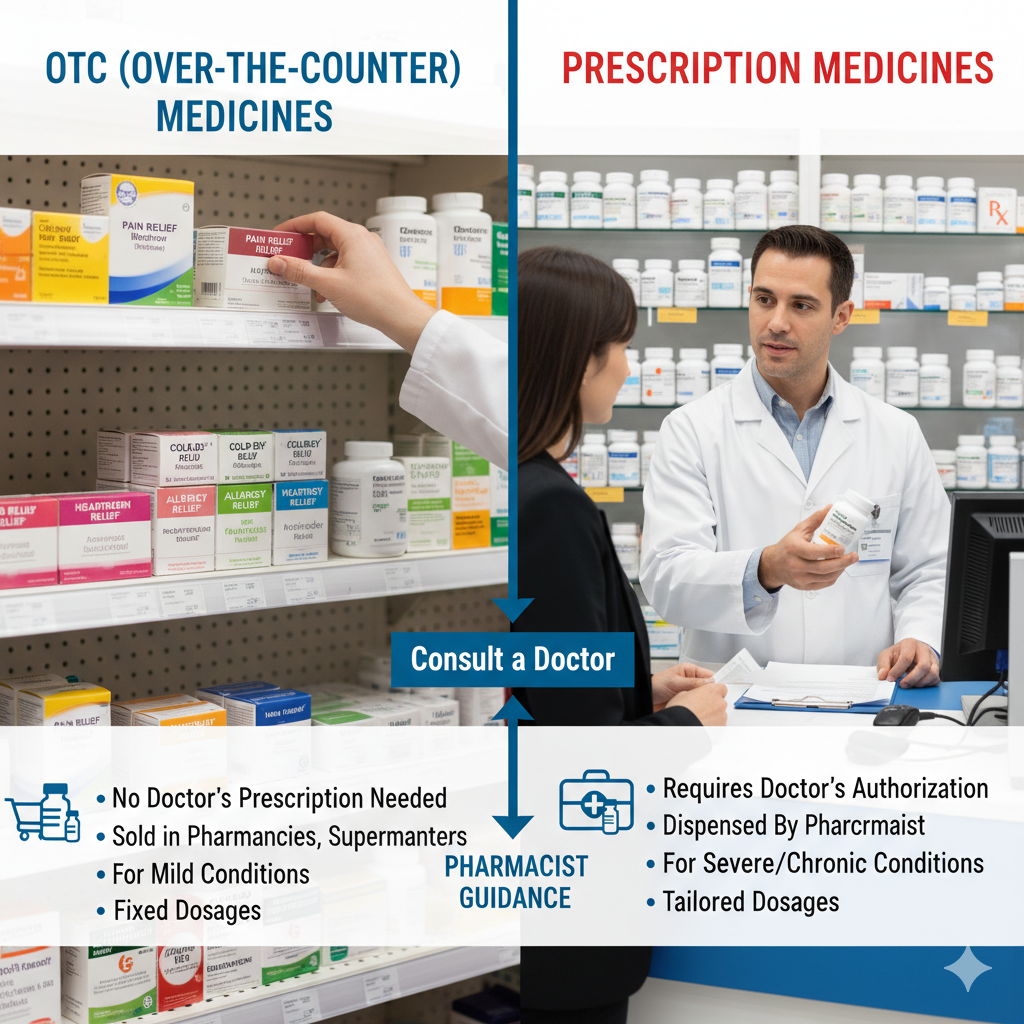What is the Difference Between OTC (Over the Counter) and Prescription Medicines: Medicines are an imperative part of human life in managing, preventing, and treating diseases. All the medicines are used for different purposes in different ways. The main distinctions in the world of medication are the difference between Over-the-Counter and prescription medicines. Knowing about this difference is pivotal for healthcare professionals, consumers, and caregivers. In this blog, we will provide you with the information of What is the Difference Between OTC (Over the Counter) and Prescription Medicines in the ensuing paragraphs.
What are OTC Medicines?
OTC(Over-the-Counter) medicines are drugs that individuals can purchase without a prescription. These can be bought from grocery stores, pharmacies, supermarkets, and online. OTC medicines are used for the treatment of mild or common ailments, like colds, headaches, digestive issues, minor skin conditions, and allergies. For instance:
- Paracetamol – for pain and fever
- Loperamide – for diarrhea
- Diphenhydramine – for allergies or as a sleep aid
- Ibuprofen – for inflammation and pain
- Antacids – for heartburn or indigestion
What are Prescription Medicines?
Prescription medicines are drugs that can be purchased without a prescription. These medicines require a written order from a licensed medical professional, like a dentist, doctor, or nurse practitioner. Prescription Medicines are used to treat complex or serious health conditions, which require supervision and diagnosis from a doctor. For example:
- Insulin: for diabetes
- Opioids: for severe pain
- Antibiotics: for bacterial infections
- Antidepressants: for mental health conditions
- Blood pressure medications: for hypertension
Key Differences Between OTC and Prescription Medicines
Have a look at the table which defines OTC vs prescription medicines means What is the Difference Between OTC and Prescription Medicines:
| Aspect | OTC (Over-the-Counter) Medicines | Prescription Medicines |
| 1. Accessibility | Available to the public without requiring a healthcare professional’s approval. | Only available with authorization from a qualified medical professional. |
| 2. Regulation & Approval | Approved by regulatory authorities for safety & effectiveness for self-use. Label must include clear directions, ingredients, and warnings. | Undergo rigorous regulatory review, including clinical trials. Requires a healthcare professional evaluation for use. |
| 3. Usage Supervision | Intended for self-diagnosed, self-limiting conditions manageable without medical supervision. | Needs diagnosis & ongoing medical monitoring to manage risks as well as side effects. |
| 4. Dosage Strength | Usually contain lower doses of active ingredients to reduce risk when used without supervision. | Often contain higher strength or more potent ingredients that require careful management. |
| 5. Labeling Requirements | Labels must be easy to understand, clear, and suitable for general public use. | Labels are more technical & tailored by pharmacists according to the physician’s instructions. |
Why Some Medicines Are OTC and Others Are Prescription?
Well, the regulatory agencies, like Health Canada, the U.S. Food and Drug Administration (FDA), or the European Medicines Agency (EMA), consider medicines based on many factors, which are mentioned below:
- Safety Profile: Can the consumer use this medicine safely without a doctor’s supervision?
- Potential for Misuse or Abuse: Medicines that have addictive properties or severe side effects are highly given on prescription.
- Complexity of Condition: Conditions that need medical diagnosis or regular monitoring, like asthma, epilepsy, and heart disease, require a prescription.
- Potential Drug Interactions: There are certain medicines that may react negatively with other medications or medical conditions, requiring professional guidance.
In some cases, a medicine may begin as a prescription or later become available OTC after years of safe use, demand, and research. For instance, omeprazole, that used to available at a prescription, and now available in lower doses OTC.
Benefits as well as Risks of OTC (Over the Counter) and Prescription Medicines
Have a look at the benefits as well as risks of OTC and prescription medicines, which are mentioned below in the table form:
| Category | Benefits | Risks |
| OTC (Over-the-Counter) Medicines | – Convenient & easily accessible
– Available without a prescription – Generally lower price |
– Risk of misuse or overuse
– Incorrect self-diagnosis – May interact with other medicines – Can mask serious underlying conditions |
| Prescription Medicines | – Tailored treatment for individual needs
– Supervised by healthcare professionals – Effective for serious or chronic conditions – More effective for complex health issues |
– Higher cost
– Risk of dependency – Potential side effects or drug interactions – Needs ongoing medical supervision & appointments |
Wrapping Up!
Both OTC and prescription medicines are imperative tools in modern healthcare; these serve different purposes. OTC medicines are produced for effective and safe use without a doctor’s supervision, making them ideal for treating minor and common ailments. Prescription medicines need medical supervision owing to the strength and complexity of the drugs. It is crucial for consumers to read the labels and take advice from medical professionals when needed or unsure. Hope the “What is the Difference Between OTC (Over the Counter) and Prescription Medicines” would be helpful for you and provide all the information you are searching for.















 call us
call us whatsapp
whatsapp Contact Us
Contact Us